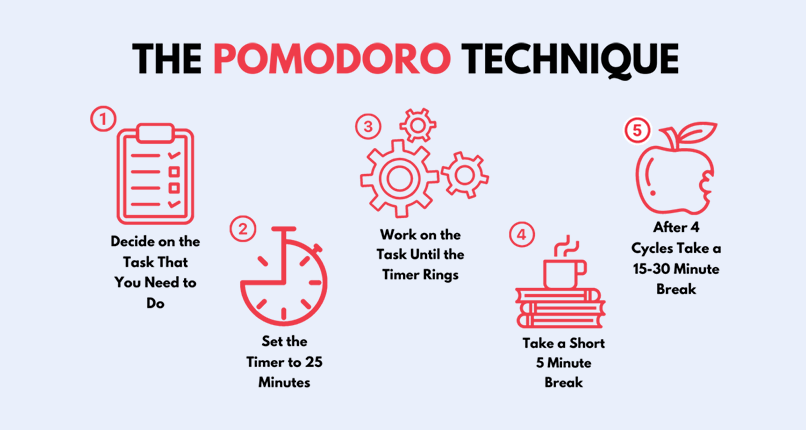
Click the button to start reading
12 Powerful Time Management Tips & Tricks for Every Style
Did you ever see the bumper sticker that read, “Warning: Dates in calendar are closer than they appear?”
Time has a way of whirring past us. And unless we find a way to maneuver through the days and weeks, deadlines creep up out of our blind spot, and we’re completely unaware.
Effectively managing time has a lot to do with understanding our personality. Some have a tendency to take on too much, while others may focus on the wrong things.
With the right techniques and tricks, it’s possible for every style, the procrastinator included, to get it all done with time to spare.
Personality and Time Management
Internal wiring plays a large part in how we approach daily activities. Optimists, as it turns out, tend to show up late. Over-committers can hardly sleep at night thinking about everything they’ve taken on. Others dabble in one project after another, oblivious to the clock and looming deadlines.
When you’re looking to understand how to better manage your time, it’s helpful, as the Delphic Maxim says, to “know thyself.”
1. The Learning Styles
Your learning style–visual, auditory or kinesthetic—can help shape a time management method that works for you.
Visual
A visual learner needs to see information. They learn best from things like graphs, charts, pictures and videos.
A system of writing everything out helps a visual learner manage time. To-do lists, a good visual calendar app, or a wall calendar are all great tools for this personality. Color-coding projects and urgent to-dos helps as well.
Auditory
Lectures, podcasts and audiobooks are the realm of the auditory learner. They learn best from listening to the spoken word.
After a meeting, auditory learners may find their heads full of everything they’ve just heard.
Creating voice memos is a way to release all the thoughts and to-dos. By turning the memos into text, everything can be organized and prioritized into to-do lists.
Kinesthetic
Kinesthetic learners want to touch, feel and do. They love being on their feet and working in groups. They need to swing the racket and pick up the ball, and are the first in line for new product releases.
A tactile method of time management works well for kinesthetic learners, such as a large calendar white board, with colored sticky notes that can be moved and arranged, depending on the project and date.

2. The Dilly-Dallier
Some people don’t think at all in terms of how many minutes are passing on the clock.
A study found that Type B people, when asked to measure the length of a minute, thought it lasted 77 seconds—17 second longer than the actual time. Extrapolated over two hours, 17 seconds is 34 minutes!
Regardless of our relationship to time, however, we’re all living within the constraints of it. It just doesn’t work if we’re chronically 34 minutes late to dropping our kids off at school, or showing up at work.
If you have Type B tendencies, then timers are your friend. When you’re completely immersed in a project and thinking of nothing else, the timer will jog you back into the time-space realm, and remind you to attend to the other commitments in your day.
3. The Procrastinator
“If it weren’t for the last minute, nothing would ever get done.”
If you have this quote pinned to your bulletin board, then you just might be a procrastinator.
Life is certainly no cake walk. Every day entails doing so many things that feel like a chore, and many of us would just as soon eat the icing first. The problem is, we can’t go for too long without mowing the lawn, paying bills, and calling the air-conditioner repair service. The cake must eventually get eaten, too!
One cure for procrastination is called “eating the frog.” This means finding the hairiest, wartiest, most repulsive item on our to-do list, and getting it over with, first thing in the morning.
Oftentimes, we put something off until the last minute because it feels too overwhelming and complicated. One way to tackle this problem is to break the project into bite-size chunks.
Take a newsletter, for example. Say you want to send out one a month. Rather than starting it 8 hours before pressing “send,” plan four weeks in advance: pick the topic in week 1, research and write the first draft in week 2, write the final draft in week 3, and save editing, formatting and photos for week 4.
It’s easy to look over the fence at someone else and marvel at all they’re able to get done. But it’s important to remember that our tendencies, styles and inclinations really make a difference in how we approach time. Your personality is the central clue as to what system works for you.

Exercises to Diagnose Time Management Traps
In the same way that money doesn’t magically appear in our bank account, we can’t conjure up an extra day each week. One can only wish.
Time is a finite resource. And in order to wrangle it around our to-dos and commitments, we must approach it as such.
These next three exercises help identify ways we might be over-committing, wasting our time, or just doing the wrong things.
4. The Over-Committer
It’s not at all uncommon to feel bogged down with endless things to do. Sometimes, even when everyone on the team diligently pulls their own weight, things just don’t seem to get done.
Working harder, smarter and faster isn’t always the solution. Sometimes, it’s a case of taking on too much.
Here is a method for identifying over-commitments.
List every single thing you do in your job, with an accurate estimate of how long each takes (some things take way longer than we realize). Next, add up the time to see how much work you’ve taken on.
If the tasks take 47.5 hours to complete each week, and you only have 40 hours in your schedule, then it’s no wonder you’re feeling snowed under.
One way to solve this problem is to off load. Maybe you can drop a project that you’re not interested in. Or scratch off things that aren’t totally necessary.
Another solution is delegation. Virtual assistants are ready-at-hand to take administrative tasks off of your plate, and allow you the brain space for innovative and creative thinking.
5. The Time Waster
Maybe we want to take on a new project, enroll in a course, or spend time with friends…but just don’t see how we can swing it with our schedule.
Every week has 168 hours, and it’s up to us how we use them.
This exercise entails looking at how we’re really spending our time—not how we think or wish we were.
For one week, record everything you do and how much time you spend at it. This includes meals and meal preparation, sleep, leisure, exercise, time with kids, work….everything. At the end of the week, look closely at the time spent in each category.
The results may unearth some surprises. Maybe you’re spending 8 or so hours watching a series on Netflix, and 3 or 4 surfing the web (shopping, reading blogs, articles). That’s quite a chunk of time!
Simply cutting this internet time in half frees up plenty of time for another commitment.
Similarly, maybe you find that you’re going to the grocery store 3 or 4 times a week. This really adds up, too. Developing a habit of grocery shopping once on the weekends creates a more efficient schedule.
6. The Wheel Spinner
Sometimes, we’re doing, doing, doing all day long, yet never seem to accomplish what we set out to do.
This exercise helps to to align our daily activities with our goals.
Write down everything you do at work for one week, and how long you spend on each task.
On a separate sheet, write down your top three goals for the quarter, or the topics you’ll discuss at your next performance review.
Look at these two lists alongside each other. Do any alarm bells go off?
It’s easy to spend hours on things that have little or nothing to do with our goals. Tasks like responding to emails and messages can take the entire day, if we let it.
As a final step, once we’ve identified any disconnect between goals and the actual workday, it’s time to put systems in place that align work habits to goals.
When we take a step back and look at the bigger picture, it’s much easier to diagnose any issues with how we’re spending our time.

Time Management Methods and Hacks
No doubt about it, life continually presents us with a steady stream of things to do. And if we put them off, they only accrue.
Fortunately, there are techniques for every temperament and personality to help keep us on track and stay productive.
7. Reverse Engineer Time
Do you find that every morning is a scramble to get out the door, and that you’re pretty much always at least ten minutes late for work?
Or that, try as you might, you’re always wrapping up a project two days after the deadline?
Reverse engineering helps Type B personalities, procrastinators, or anyone who has a hard time meeting deadlines.
The first step in reverse engineering is to identify the end objective. Maybe it’s to arrive at work by 8 am, or complete a project by Friday. Then, list every task that precedes this finish line.
If your plan is to arrive to work on time, then things on your list might include: get dressed, make breakfast, get kids dressed, walk the dog, drop kids off at school, drive to work.
Next, gauge how long each item on the list takes, and add them up. If everything takes 2.5 hours, then guess what? The alarm is going off at 5:30 (ouch!).
8. Time Block
Some of us have a visceral response to a long to-do list. They make us feel swamped, right out of the gate.
Or maybe we’re precluded from staying on task by a constant deluge of messages and notifications on our phone.
Time blocking helps with these problems. It works just like it sounds: identify the various things you do during the week, then assign blocks of time in which to do them.
Dixie Willard uses this method in her business, Designing Dixie:
“I know that Mondays are my marketing and money days, so that’s the day I’m going to do my bookkeeping, schedule social media posts. I write my blog posts. Marketing-oriented things. Tuesday mornings are small group, then I record my podcast, then client work. Wednesdays and Thursdays are out-and-about days with clients. Then Friday I am back in the office…and then Sundays are fun. I know I have time set aside to take care of things.”
With time blocking, you won’t need a lot of lists, as you’ll already know when you’re doing what.
It’s important to turn off notifications when working on a task, in order to maintain productivity and focus during that block of time.
If responding to dozens of messages is part and parcel to doing your job, then blocking time to do this—say for 30 minutes every 2 hours—allows you to maintain focus on all the other tasks in your day as well.

9. Plan Tomorrow Tonight
In the first hours of the morning, most of us are still shaking off the morning fog. And even after several cups of coffee, we’d much prefer to delegate anything that requires thinking too hard.
Creating a daily agenda from this frame of mind is a lot to ask of ourselves.
When you’ve planned your day the night before, rather, all you have to think about in the morning is drinking coffee and getting yourself to work.
Brian Tracy, author of Eat that Frog: 21 Great Ways to Stop Procrastinating and Get More Done in Less Time, says it also increases productivity:
“When you make your list the night before, your subconscious mind will work on your list all night long while you sleep. Often you will wake up with great ideas and insights that you can use to get your job done faster and better than you had initially thought.”
When your day is already planned, you don’t have to give yourself a pep talk over the morning latte, or think through the daily minutia, with your head full of fuzzies. Right from when you step out of bed, you have focus and momentum.

10. Use Pomodoro Method
Oftentimes, we have great focus first thing in the morning, but after two hours, we’re distracted and dawdling. Other times, it’s hard to even get started on a project that’s complicated or overwhelming.
The Pomodoro method involves working in small time increments to keep focus sharp. It was developed by Francesco Cirillo, a business consultant, in the late 1980s.
With this method, you set a timer and work on a specific task for 25 minutes. Then, take a short break and work again for 25 minutes. After four sessions, take a fifteen or thirty minute break.
It’s helpful at the beginning of the 25 minutes to set a goal for what you hope to achieve by the end of it. For example, “complete three invoices” or “write two Instagram captions.”
The small breaks let our mind rest and rejuvenate, so we’re ready to focus again in the next spurt.
This method is useful for tasks you want to put off–you can do anything for 25 minutes, right?
11. Try Batching
You know how when you’ve done something a few times, it becomes really fluid and takes less time?
Batching is a time management method of doing many of the same tasks all at once, and getting it out of the way.
For example, rather than cooking dinner every night, you can batch meals on the weekends, or one Saturday a month, and freeze them all. It saves so much time during the week when dinner preparation simply entails pulling lasagna out of the freezer and heating it up.
Monthly social media and blog posts also work well for batching. You can write everything on a single day, and then schedule content throughout the month.

12. Set up Systems and Routines
Did you remember brushing your teeth this morning? Some parts of our lives are so routine we do them without even thinking about it.
A system is not unlike a daily habit. When we set up a system around a task, it takes less effort to complete. After a while, we’re so used to the process that we complete tasks without having to think too much about them.
For example, when we open our inbox to dozens of unread emails, business coach Lydia Kaplygin recommends the “4 D” system for going through them:
- Do: An email that needs to be responded to right away.
- Delete: Junk mail that goes away forever.
- Delegate: Messages we forward to another person.
- Defer: Something we need to do, but not immediately.
When we create systems like this around everything we do, it saves time and decreases burnout and overwhelm.
Other areas where we can create systems include: a morning routine, blog posts, paying bills, creating invoices and payroll.
A Steady Trait
The hare, as we all know, was fast, but he wasted his time.
Time management isn’t about being the most skilled or the fastest. It’s about being strategic. And consistent.
Slow and steady is one characteristic we all could stand to take on. With methodical habits, we meet deadlines and achieve goals.
What time management trick has helped you cross finish lines?
















